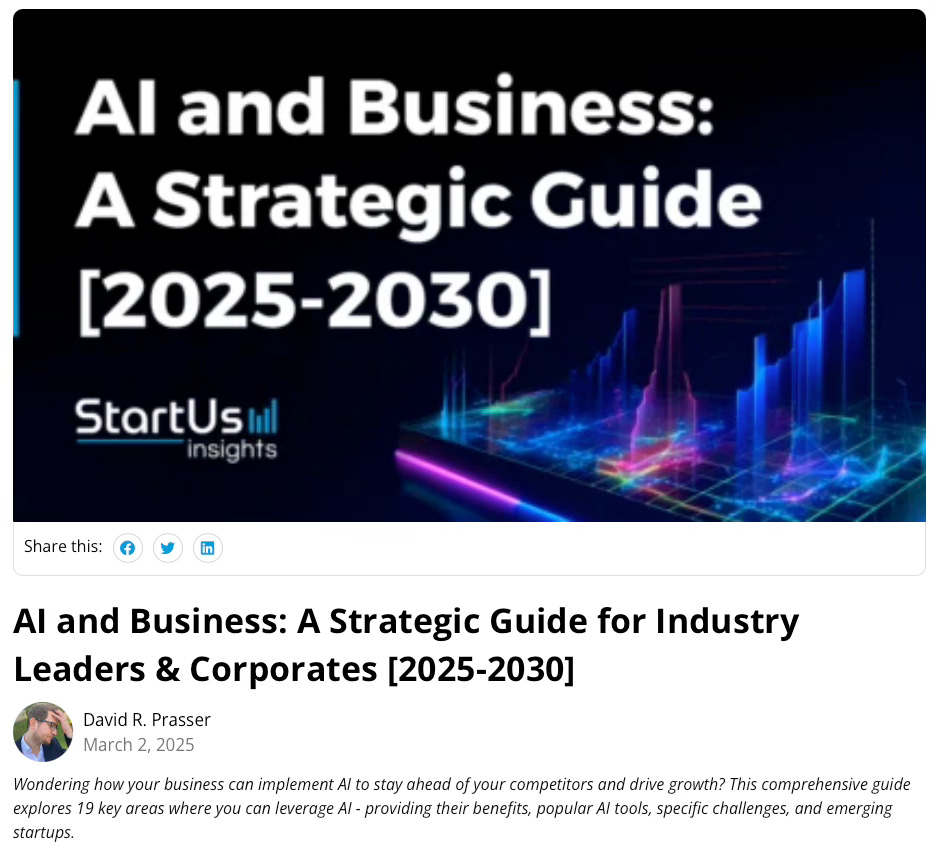- Pascal's Chatbot Q&As
- Posts
- GPT-4o: Artificial Intelligence (AI) is no longer an experimental technology—it is a fundamental driver of business transformation.
GPT-4o: Artificial Intelligence (AI) is no longer an experimental technology—it is a fundamental driver of business transformation.
The key question for business leaders is not if AI should be adopted, but how and where it should be implemented.
AI and Business: A Strategic Guide (2025-2030) – Executive Summary for C-Level Leaders
by ChatGPT-4o and based on “AI and Business: A Strategic Guide for Industry Leaders & Corporates [2025-2030]”.
Introduction
Artificial Intelligence (AI) is no longer an experimental technology—it is a fundamental driver of business transformation. The global AI market is projected to reach $757.58 billion by 2025 and $3.68 trillion by 2034, with a massive surge in investment. The key question for business leaders is not if AI should be adopted, but how and where it should be implemented.
This guide identifies 19 crucial areas where AI can add significant value across industries. From operational efficiency to customer engagement and strategic decision-making, AI is reshaping the corporate landscape.
Key Takeaways for Business Leaders
The document provides actionable insights on how AI can be strategically integrated across business functions. Below are the most critical takeaways:
1. AI is a Competitive Necessity, Not a Luxury
90% of business leaders see AI as central to their strategy.
80% of companies will have adopted generative AI tools by 2026.
AI-driven companies will outperform competitors by at least 25% in efficiency and revenue growth.
2. AI Improves Productivity and Efficiency Across Functions
AI is revolutionizing traditional workflows by automating tasks, optimizing processes, and enhancing decision-making. The guide identifies the following key areas:
AI for Knowledge Work & Productivity
AI-Driven Brainstorming & Ideation: Tools like ChatGPT, Notion AI, and MindMeister enhance creativity and speed up innovation.
AI for Email & Communication: AI-driven personalization increases email engagement rates by 29%.
Meetings & Notes Automation: AI-powered transcription tools like Otter.ai and Fireflies.ai save employees up to 2 hours per day.
Knowledge Management: AI reduces internal support requests by 30% by organizing and retrieving information efficiently.
AI for Operational Efficiency & Automation
Business Process Optimization: AI automation can reduce operational costs by up to 30% and increase efficiency by 25%.
IT Operations & Cybersecurity: AI-powered IT management improves system reliability, detecting threats faster than human monitoring.
Predictive Maintenance: AI reduces equipment downtime by up to 50%, saving millions in repair costs.
AI for Sales & Marketing
Content Generation: 90% of marketers are now using AI for content production, but concerns over authenticity are rising.
Personalized Customer Engagement: AI-driven recommendations increase conversion rates and customer satisfaction.
Sales Forecasting & CRM: AI-driven analytics improve demand forecasting, reducing inventory issues and lost revenue.
AI for Financial & Legal Applications
Fraud Detection: AI identifies suspicious transactions in real time, reducing financial risk.
Legal Automation: AI speeds up contract review, reducing legal workload and compliance risks.
AI for Strategic Decision-Making
Data-Driven Insights: AI analyzes complex datasets to provide actionable insights for leadership teams.
Risk Mitigation: AI helps anticipate potential crises before they escalate.
Strategic Implementation: What Business Leaders Need to Know
1. Align AI Adoption with Business Goals
Rather than investing in AI for the sake of innovation, companies should identify specific business problems that AI can solve.
2. Prioritize Ethical AI & Compliance
AI must be implemented with transparency, fairness, and privacy considerations.
Companies need to establish AI governance frameworks to avoid regulatory risks.
3. Invest in AI Talent & Infrastructure
Successful AI adoption requires upskilling employees and integrating AI into existing workflows.
Collaboration between AI teams and domain experts ensures AI is applied effectively.
4. Monitor and Adapt to AI Trends
AI evolves rapidly, and businesses must stay ahead by continuously updating their AI strategy.
Partnering with AI startups and vendors can provide cutting-edge solutions.
Final Thoughts
AI is not just a tool—it is a business imperative. Companies that strategically integrate AI will gain a significant competitive advantage, while those that hesitate risk falling behind. Leaders must take a proactive approach to AI adoption, ensuring that AI aligns with business priorities, enhances productivity, and adheres to ethical and regulatory standards.
Actionable Next Steps for Business Leaders:
✅ Identify key business areas where AI can drive the most impact.
✅ Invest in AI tools that align with your strategic goals.
✅ Build a culture of AI adoption by upskilling teams.
✅ Monitor AI advancements and adjust your AI roadmap accordingly.
By embracing AI as a business enabler, organizations can unlock new opportunities, drive efficiency, and stay ahead in the digital economy. 🚀
